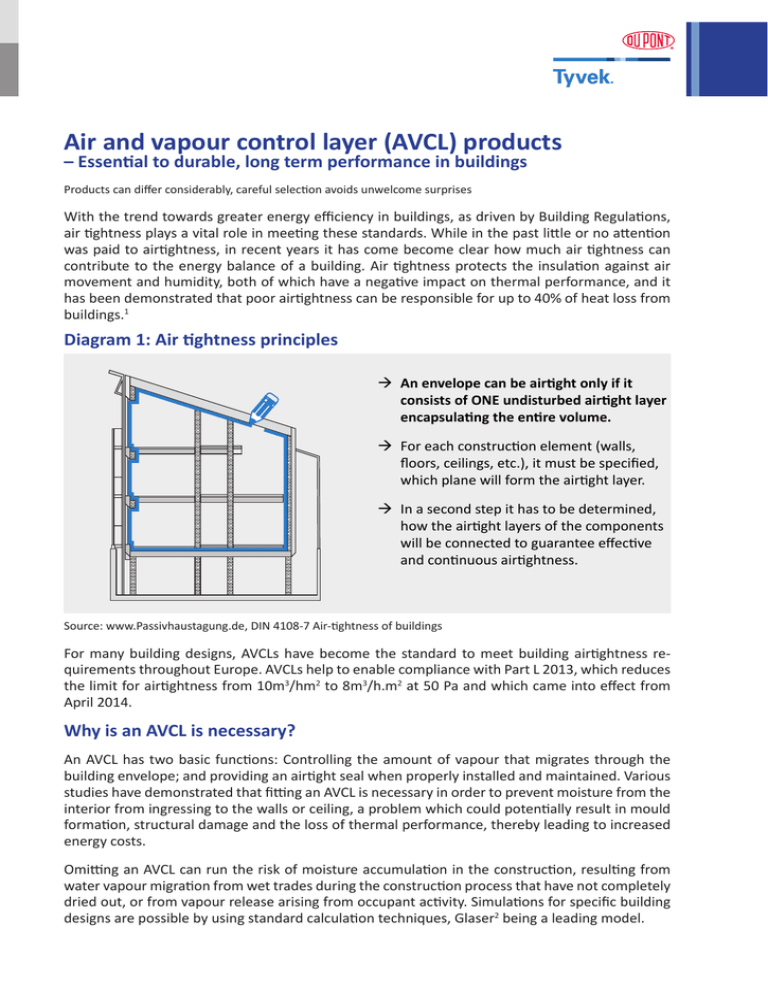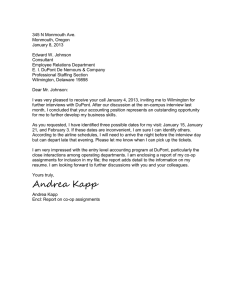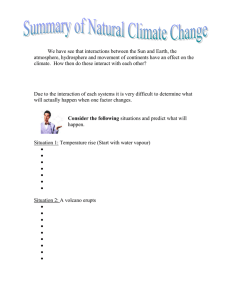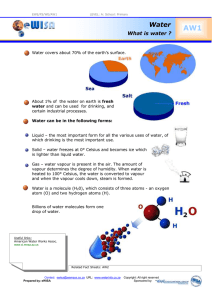
Air and vapour control layer (AVCL) products
– Essential to durable, long term performance in buildings
Products can differ considerably, careful selection avoids unwelcome surprises
With the trend towards greater energy efficiency in buildings, as driven by Building Regulations,
air tightness plays a vital role in meeting these standards. While in the past little or no attention
was paid to airtightness, in recent years it has come become clear how much air tightness can
contribute to the energy balance of a building. Air tightness protects the insulation against air
movement and humidity, both of which have a negative impact on thermal performance, and it
has been demonstrated that poor airtightness can be responsible for up to 40% of heat loss from
buildings.1
Diagram 1: Air tightness principles
An envelope can be airtight only if it
consists of ONE undisturbed airtight layer
encapsulating the entire volume.
For each construction element (walls,
floors, ceilings, etc.), it must be specified,
which plane will form the airtight layer.
In a second step it has to be determined,
how the airtight layers of the components
will be connected to guarantee effective
and continuous airtightness.
Source: www.Passivhaustagung.de, DIN 4108-7 Air-tightness of buildings
For many building designs, AVCLs have become the standard to meet building airtightness requirements throughout Europe. AVCLs help to enable compliance with Part L 2013, which reduces
the limit for airtightness from 10m3/hm2 to 8m3/h.m2 at 50 Pa and which came into effect from
April 2014.
Why is an AVCL is necessary?
An AVCL has two basic functions: Controlling the amount of vapour that migrates through the
building envelope; and providing an airtight seal when properly installed and maintained. Various
studies have demonstrated that fitting an AVCL is necessary in order to prevent moisture from the
interior from ingressing to the walls or ceiling, a problem which could potentially result in mould
formation, structural damage and the loss of thermal performance, thereby leading to increased
energy costs.
Omitting an AVCL can run the risk of moisture accumulation in the construction, resulting from
water vapour migration from wet trades during the construction process that have not completely
dried out, or from vapour release arising from occupant activity. Simulations for specific building
designs are possible by using standard calculation techniques, Glaser2 being a leading model.
Diagram 2 shows the potential risk of water vapour transmission into the construction if an interruption in the airtight layer occurs.
Diagram 2: Risk of airtightness interruption
10mm
S
-10°C; 80 %
20°C; 50 %
Construcon
layer thickness
100
10Pa
5Pa
3Pa
1Pa
50
0
0,5
1
1,5
Gap width S
2 [mm]
Water vapour transmission
Water vapour transmission
Pressure difference
150
0
20°C; 50 %
[g/mh]
200
[g/mh]
200
-10°C; 80 %
100mm
S
Pressure difference
150
100
50
0
0
0,5
1
1,5
Gap width S
2 [mm]
Source: Gerd Hauser, Anton Maas, Universität Kassel, Germany, published by DBZ (1992, He 1, page 97-100)
Effective sealing of the building envelope requires both good workmanship and the right choice
of AVCL. Water vapour, which can find many ways into the construction, is difficult to control and
could result in risks to both the building and its occupants.
Table 1: Examples of moisture creation in buildings
MOISTURE EXAMPLES3
Water used in construction
Plaster, concrete, masonry require large volumes of water
Precipitation during construction
Rainwater
Snow
Installation quality
Special attention shall be given to penetrations, as for example:
• Loft hatches
• Windows
• Doors
• Partition walls
• Joints
• Etc.
Building in use
Building occupancy generates moisture
People
• Asleep
40g/h.person
• Seated, office work
70g/h.person
• Standing, housework
90g/h.person
• Moderate manual work 300g/h.person
Effective drying out of a building can sometimes be difficult to achieve, especially as the moisture
content of some construction materials is not always obvious. Once the building is in use, diffusion
and convection are the typical methods of moisture migration into the structure. Diffusion takes
place via pressure differences between the interior and the exterior. During winter, diffusion takes
place from the building interior towards the exterior whereas, during the summer, the vapour
drive is from outside to in. How much vapour can pass through the airtightness layer depends on
its resistance to diffusion (MNs/g or sd-value expressed in m). Convection takes place by air flow,
for example through poor joints. A high degree of convective vapour can result in high moisture
accumulation in the insulation layer resulting potentially in a considerable risk of condensation.
Vapour diffusion can be calculated based on the likely environmental conditions and vapour resistance of the airtightness layer. The extent of convective vapour drive, together with built-in moisture, however, is difficult to assess, but can be effectively limited through high quality installation.
AVCLs can differ significantly
Any AVCL should be airtight by definition. The degree of vapour diffusion, however, depends on
the material composition. It can be distinguished by four different product technologies: Monolithic (solid) Polyethylene membranes, typically with high and fixed sd-values; Composite AVCL
membranes with low to medium fixed sd-values; Reflective AVCLs; and AVCLs with variable sd-values by means of humidity concentration.
Table 2: AVCL product technologies
POLYETHYLENE
MEMBRANES
COMPOSITE AVCL
MEMBRANES
VARIABLE AVCL
MEMBRANES
REFLECTIVE AVCLS
Sd-value (m)
>= 20m up to 100Vapour
150m and above
resistance
expressed as
equivalent air
layer thickness
From 2m up to 25m
0.3to 5m*
0.25to 10m**
0.05 to >30m***
The lower
the low value and the
higher the high value
the better
the performance.
>100m for composites
with metallised
surface
>500m for composites
with aluminum foil
Vapour
resistance
(MNs/g)
>=100MNs/g up to
500-750MNs/g and
above
10MNs/g up to
125MNs/g
1.5 to25MNs/g*
1.25 to 50MNs/g**
0.25 to
>150MNs/g***
>500MNs/g for
composites with
metallised surface
>2500MNs/g for
composites with
aluminum foil
Product
technology
examples
Standard Polyethylene Coated spunbond
membranes
polyprop, thermally
bonded polyprop or
polyester nonwovens
Spunbond polyprop/
polyamide laminate*
Spunbond polyprop/
Polyethylene
copolymer**
DuPont™ Airguard®
technology***
Polyethylene,
Polypropylene or
polyester metallised
foils
Spunpond reinforced
layers of aluminum foil
*Isover Vario KM
Duplex
**Proclima Intello®
***DuPont™
Airguard® Smart
Proctor Reflectatherm
Plus
Protect VC Foil Ultra
DuPont™ Airguard®
Reflective
Product
examples
Siga Majpell 5
DAFA DiFoil™
DuPont™ Airguard®
Control
Under normal room humidity levels (40-70%), the water vapour resistance of a variable AVCL will
not only block moisture transmission during the winter months, but also enables drying out of
unwanted humidity during the summer months. In general, the higher the sd-value, the higher
the moisture resistance during winter conditions, but conversely, the lower the drying out potential during summer weather. High vapour tightness reduces the capacity of a membrane to allow
moisture trapped within the construction to dry out easily.
Many roof and wall assemblies are only durable if they can dry-out to the interior side as well4
In many cases moisture damage can be attributed to the fact that a vapour barrier is practically
impermeable in both directions, i.e. it does not permit any drying out.5
Polyethylene membranes are typically offered with sd-values ranging from >=20m up to 100150m (>=100MNs/g up to 500-750 MNs/g and above). Due to their high vapour resistance, they
can quickly become a moisture trap, as drying out of the construction toward the room side is
rarely possible.
AVCLs with a variable sd-value offer excellent protection against condensation risk and potential
damage due to the adaptation of their water vapour resistance by means of humidity concentration. During the winter the sd-value of the membrane increases as the relative humidity within
the building interior increases, thus reducing moisture transfer towards the insulation when vapour control is needed most. The sd-value decreases as the relative humidity drops during the
summer months, allowing the construction to dry out towards the interior.
The broader the sd-value range of a variable AVCL, the higher the humidity protection. The lower
sd-value represents the drying out potential of a variable AVCL during summer months. A difference of 0.2-0.25m may sound small, but this can have a big impact if humidity is trapped within
the construction. The upper sd-value represents the water vapour transmission during winter
months, the higher the value the less moisture will penetrate from the room side towards the
insulation.
DuPont has developed a special laminate technology enabling a lower sd-value of 0.05m
(=25MNs/g) and an upper sd-value of 30m (=150MNs/g) for its adaptable AVCL DuPont™ Airguard® Smart. DuPont™ Airguard® Smart provides outstanding humidity protection compared
to other AVCLs, and helps to accelerate the drying out process of wet construction materials. Its
capacity is approximately 1400-2000 times greater than Polyethylene membranes with an sd-value of 75-100m (375-500 MNs/g) and 5-6 times greater than comparable AVCLs with a variable
sd-value.
Diagram 3: AVCLs with fixed sd-value in comparison
Drying out potenal of AVCLs by sd-value
during summer month (g/m2 24h)
Source: DuPont, moisture diffusion at 1000Pa, calculated according to DIN4108-3
(g/m2 24h)
3.20
0.70
DuPont™ Airguard®
Control, 5m
DuPont™ Airguard®
sd23, 23m
0.16
0.23
Polyethylene
membrane, 100m
Polyethylene
membrane, 70m
0.01
DuPont™ Airguard®
Reflecve, 2000m
Diagram 4: AVCLs with variable sd-value in comparison
Drying out potenal of AVCLs by sd-value
during summer month (g/m2 24h)
Source: DuPont, moisture diffusion at 1000Pa, calculated according to DIN4108-3
320.00
(g/m2 24h)
64.00
DuPont™ Airguard® Smart, 0.05m > 30m
Spunbond polyprop/Polyethylene
copolymer, 0.25m - 10m
53.33
Spunbond polyprop/Polyamid laminate,
0.3m < 5m
Diagram 5: AVCL performance in flat roof construction with plywood
0.021m and mineral wool, 0.35m thick layer, climate London
Total water content kg/m2
Source: DuPont, calculated by WUFI soware program
Plywood water content kg/m2
Source: DuPont, calculated by WUFI soware program
4.00
200
3.50
180
160
3.00
140
2.50
120
2.00
100
1.50
80
60
1.00
40
0.50
20
0.00
1-Jul-12
0
1-Jul-13
1-Jul-14
1-Jul-15
1-Jul-16
1-Jul-17
Polyethylene membrane, sd = 20m
Spunbond polyprop/polyamid laminate, sd = 0.3m < 5m
Spunbond polyprop/Polyethylene copolymer, sd = 0.25m - 10m
DuPont™ AirGuard® Smart, sd = 0.05m > 30m
1-Jul-12
1-Jul-13
1-Jul-14
1-Jul-15
1-Jul-16
1-Jul-17
Polyethylene membrane, sd = 20m
Spunbond polyprop/polyamid laminate, sd = 0.3m < 5m
Spunbond polyprop/Polyethylene copolymer, sd = 0.25m - 10m
DuPont™ AirGuard® Smart, sd = 0.05m > 30m
Diagram 6: Water vapour transmission risk of AVCLs
with adaptable sd-value
Water vapour transmission during winter months (g/m2 24h)
Source: Calculated by DuPont, according to EN 1931
(g/m2 24h)
7.8
3.6
1.1
DuPont™ Airguard® Smart, 0.05m > 30m
Spunbond polyprop/Polyethylene
copolymer, 0.25m - 10m
Spunbond polyprop/Polyamid laminate,
0.3m < 5m
For rooms with extreme humidity levels (>70%), AVCLs with high sd-values are recommended
for installation after the drying out of construction materials. Special care should be given to the
installation method to avoid moisture being trapped in the construction, since the high sd-value
does not allow for drying out during summer months.
DuPont Building Innovations offers a range of AVCL products covering a broad range of applications: DuPont™ Airguard® Control, 25MNs/g, which is suitable for roofs, walls and floors with a
diffusion open outer layer. This is a mechanically strong membrane with less risk of damage during
installation, it is also translucent making it ideal for air-blown insulation applications and can be
easily located for fixing; DuPont™ Airguard® Reflective, 10 000MNs/g: This is a 100% air and vapour tight AVCL. It has a metallised surface with a very low emissivity which significantly improves
its thermal insulation performance, providing an additional 0.58-0.80 m2K/W to the R-value.6 It is
ideal for applications with high humidity that require high vapour resistance; DuPont™ Airguard®
Smart is an exceptional membrane with highly adaptable vapour resistance. It helps to protect
against structural mould damage due to its high drying out potential, furthermore its flexibility
combined with excellent robustness, makes it easy to install and handle.
The selection of an AVCL depends on a number of criteria, as for example room humidity level, the
external sd-value or the diffusion openness of the insulation. DuPont has developed a product selector to help choose from its range of AVCL products. The technical hotline team is also available
to assist you with further information on application specific questions.
Table 3: DuPont Airguard® AVCL product selector
DUPONT™
AIRGUARD®
CONTROL
Normal room humidity, ~40%-70%
High room humidity, >70%
Roof type
Flat
Pitched > 10°
Roof Covering
Metal
Tiles
Single ply/bitumen
Wall
Floor
External Sd-value
Low
High
Insulation
Diffusion open (μ≤10) eg.:
Stone wool, glass wool, wood
fibre, cellulose fibre, etc.
Diffusion closed (μ>10) eg.:
EPS, XPS, PUR/PIR, phenolic
foam, foam glass
Legend: green: recommended, red: not recommended, yellow: case specific
DUPONT™
AIRGUARD®
SD 23
DUPONT™
AIRGUARD®
REFLECTIVE
DUPONT™
AIRGUARD®
SMART
Picture 1: DuPont™ Airguard® Smart
Picture 2: DuPont™ Airguard® Control
Authors:
Nick Williams, Technical Manager UK & Ireland, Du Pont (U.K.) Limited
Norbert Frey, Technical Specialist, DuPont de Nemours S.àr.l., Luxembourg
Tobias Mehlsam, New Business Development Manager Western Europe DuPont de Nemours
(Deutschland) GmbH
Ulrike Koster, Marketing Specialist, DuPont de Nemours S.àr.l., Luxembourg
L-11380 - Copyright © 2014 DuPont. All rights reserved. The DuPont Oval Logo, DuPont™, The miracles of science™, Tyvek®, AirGuard® and all products denoted with ® or ™ are
registered trademarks or trademarks of E. I. du Pont de Nemours and Company or its affiliates. 04/2014
NHBC Foundation, Michael Jaggs and Chris Scivyer, BRE: A practical guide to building airtight dwellings, June 2009
1
DIN 4108-3
2
BSI Starndards Publication: BS 5250:2011 – Code of practice for control of condensation in buildings
3
Fraunhofer Institut für Bauphysik, H. B. Künzel: Adapted vapour control for durable building enclosures, April 2005
4
Fraunhofer Institut für Bauphysik, H. B. Künzel: Adapted vapour control for durable building enclosures, April 2005
5
BBA certificate: Where this faces into an unventilated cavity this corresponds to the following cavity thermal
resistance values. Walls, a cavity > 20 mm thick: 0.67 m2·K/W, Floors, a cavity > 17 mm thick: 0.58 m2·K·W,
Floors, a cavity > 25 mm thick: 0.80 m2·K·W
6




